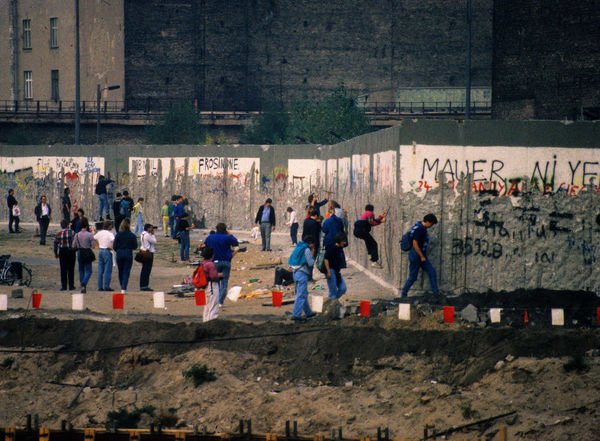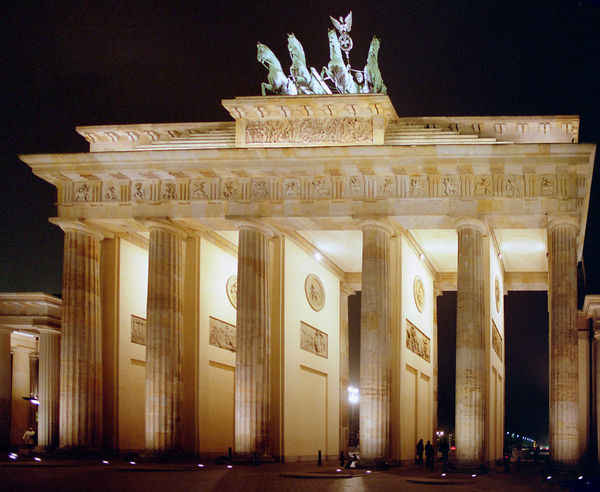Berlin Then and Now
By Rick Steves

Whenever I visit Berlin I can't help remembering my spooky Cold War visit back in 1971. I vividly recall how, after we'd toured East Berlin, our tour bus was stopped and emptied at a border crossing so mirrors could be rolled under the bus before we returned to West Berlin. The guards wanted to see if anyone was trying to hitch a ride to freedom with us. (For a 16-year-old who was caught up in the anxiety of the Cold War, that left quite an impression.)
For nearly 30 years the Berlin Wall divided Germany's biggest city in two. Back then, life in the East was bleak, gray, and demoralizing because of ongoing political repression and their unresponsive Soviet-style command economy.
Today, long-united Berlin feels like the nuclear fuel rod of a great nation. It's vibrant with youth, energy, and an anything-goes-and-anything's-possible buzz.
A sleek Radisson Collection Hotel stands where East Berlin's leading hotel, the Palasthotel, once stood. I remember staying there during the Cold War, when a West German 5-mark coin changed on the black market would get me drinks all night. Now, stepping into the Radisson, five euros is lucky to get me a beer. Its over-the-top lobby is famous for hosting an eight-story exotic fish tank the size of a grain silo — with an elevator zipping right up the middle — that burst in 2022, killing countless fish (worth Googling).
As a booming tourist attraction, Berlin now welcomes as many visitors in a year as Rome does. The crush of tourists makes parts of the new Berlin tacky — even some sights associated with the Wall. Checkpoint Charlie, the famous border checkpoint between the American and Soviet sectors, can feel like a capitalist freak show. Shifty characters sell fake bits of the Wall, World War II-vintage gas masks, and East German medals. Two actors dressed as American soldiers pose for tourists between big American flags and among sandbags at the rebuilt checkpoint guard shack. Across the street at "Snack Point Charlie," someone sipping a Coke said to me that "when serious turns to kitsch, you know it's over."
Nearby, the Museum of the Wall at Checkpoint Charlie, one of Europe's most cluttered museums, survives as a living artifact of the Cold War days. The yellowed descriptions, which have scarcely changed since that time, tinge the museum with nostalgia. It's dusty, disorganized, and overpriced, with lots of reading involved, but all that just adds to this museum's borderline-kitschy charm. (And it's open late — if you're pressed for time, it makes a decent after-dinner sight.)
Look for a double row of cobbles in the streets marking the former path of the 100-mile "Anti-Fascist Protective Rampart," as the communists called the Wall. These innocuous cobbles run throughout the city, even through some modern buildings.
The Wall's most iconic sight, of course, is the Brandenburg Gate. Built in 1791, it's the last survivor of 14 gates in Berlin's old city wall. The gate was the symbol of Prussian Berlin...and later the symbol of a divided Berlin. It sat unused, part of a sad circle dance of watchtowers and barbed wire, for more than 28 years.
Postcards all over town still show the ecstatic day — November 9, 1989 — when the world enjoyed the sight of happy Berliners jamming the gate like flowers on a parade float. While the now-gleaming Brandenburg Gate was completely restored in 2002, you can still see faint patches marking war damage. When I'm there, I like to pause a minute to think about struggles for freedom — past and present; there's a special room built into the gate for this very purpose.
While tourists flock to Checkpoint Charlie, the newer Berlin Wall Memorial is the city's most substantial attraction relating to its gone-but-not-forgotten Wall. Exhibits line up along four blocks of Bernauer Strasse, stretching northeast from the Nordbahnhof S-Bahn station. You can enter two different museums plus various open-air exhibits and memorials, see several fragments of the Wall, and peer from an observation tower down into a preserved, complete stretch of the "Wall system" (with both sides of its Wall and its no-man's-land, or "death strip," all still intact).
The lengthiest still-standing stretch of the Wall is now "the world's longest outdoor art gallery": the East Side Gallery near Berlin's Ostbahnhof train station. Murals by international artists cover nearly a mile of the concrete panels. The artwork is routinely whitewashed so new works can be painted.
No tour of Germany is complete without a visit to the reunited, revitalized Berlin. Over our lifetimes we've witnessed the rebirth of a great European capital. Today, as we enjoy the thrill of walking over what was the Wall and through the well-patched Brandenburg Gate, it's clear that history is more than a story contained in some book. It's an exciting happening unfolding all around us, right now.

